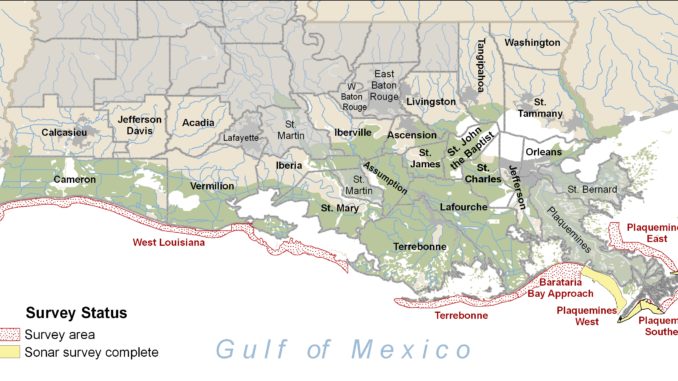
The National Oceanic and Atmospheric Administration (NOAA) has enhanced its Gulf of Mexico Marine Debris Project website. The changes in the site reflect changes in the program and emphasize NOAA’s collaboration with the U.S. Coast Guard (USCG) and the State of Louisiana’s inshore debris program coordinated by Louisiana Department of Natural Resources and the Governor’s Office of Homeland Security and Emergency Preparedness.
The project began in 2006 to assist with economic recovery in Alabama, Mississippi and Louisiana following Hurricane Katrina. The initial goal was to reopen the hard-hit commercial Gulf fisheries in these states because the fishing boats that survived the storm were hindered by debris the hurricane cast into the water. NOAA’s offshore survey was extended in 2007 to cover an expansive amount of Louisiana coast, including areas struck by Hurricane Rita. The Gulf of Mexico Marine Debris Project has three main objectives: 1. improve maritime safety and commerce 2. update the state’s nautical charts, and 3. provide information on sunken debris to agencies that can remove it.
Led by NOAA’s Office of Response and Restoration and Office of Coast Survey, the program employs boats equipped with three different types of sonar to scan offshore water bottoms. Once an object or “target” is found, the item’s location, clearance and GPS coordinates are recorded and mapped. This data is then reported on the website where it can be easily accessed, free of charge, by boaters and the general public.
The updated site still reports results of NOAA’s ongoing work, but has been expanded to include information on inshore debris surveys and removal efforts conducted by other agencies.
“A user can click on a surveyed offshore area and download maps displaying these sonar targets,” said Project Manager Nir Barnea of NOAA. “Likewise, a user may click on the name of a parish, then click on a specific waterway and view maps and photos provided by the U.S. Coast Guard to become informed about potential boating hazards.”
Robert Travis serves as the deputy incident commander for the last remaining USCG mission assignment in support of Hurricane Katrina debris removal at the USCG command post in Mandeville. Travis said the Coast Guard’s original post-storm mission was to open “commercially navigable waterways.” In Louisiana, that mission last year expanded to include debris removal in any “usually traveled” waterway in 27 Louisiana parishes from Texas to the Mississippi border. In addition to conducting their own surveys of inshore waterways and coordinating removal of items that qualify under strict Federal Emergency Management Agency guidelines, the Coast Guard is evaluating NOAA’s offshore targets to see which ones can be removed using FEMA funds.
Louisiana Sea Grant (LSG) is continuing local outreach for the survey and website. LSG and LSU AgCenter Marine Extension agent Thu Bui is making sure hazard information is accessible to the state’s Vietnamese fishermen. She is working through language barriers and reaching constituents who may not have computers or may not regularly use the internet. Help for these fishermen, as well as anyone else without Web access, is only a phone call away, as Sea Grant will provide debris maps and coordinates by mail upon request.
“Since 2006, nearly 50,000 people have visited the project website,” said Paula Ouder, editor with the LSG Communications Department who is coordinating the Louisiana outreach campaign. “It’s wonderful that we now have a clearinghouse of marine debris information not only for NOAA’s offshore mission, but for the state and Coast Guard programs working to cleanup inshore waters.”
NOAA’s offshore survey work is expected to continue through the end of 2008. Boaters or residents who have found debris in inshore waters should contact the Louisiana Department of Natural Resources to report it.
More information:
• Gulf of Mexico Marine Debris Project, http://gulfofmexico.marinedebris.noaa.gov/
• Thu Bui, LSG/LSU AgCenter Marine Extension: (337) 828-4100 or TBui@agcenter.lsu.edu
• Paula Ouder, LSG Communications: (225) 578-6451 or pouder@lsu.edu
• Louisiana Department of Natural Resources, 1 (866) 579-4-DNR or www.LouisianaMarineDebris.com


